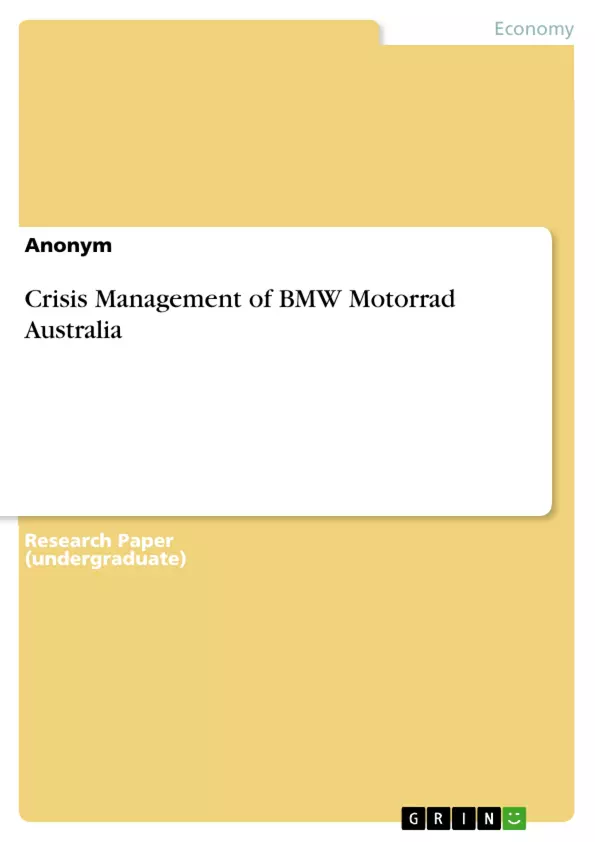1. Introduction
This assignment deals with the management of crisis. First of all, crisis and company crisis will be defined. Secondly, the characteristics of a crisis will be identified. Furthermore, theory about crisis management and crisis planning will be provided. In this context, guidelines, preparation and goals of crisis management will be described. Moreover, different tables will provide additional information and describe the crisis management of BMW.
1.1 Crisis definition
According to Heath and Millar (2004, p. 2), a crisis is an inappropriate and inconvenient event that has negative consequences for everybody who is concerned. Argenti (2009, pp. 258-259) states that a crisis is a “major catastrophe” and argues that these catastrophes are either a result of “natural disaster” or “caused by human error, negligence, or ... malicious intent”. Argenti (2009) argues that a crisis is something everybody can identify with.
1.2 What is a company crisis?
Stacks (2004) states that all organisations will at some time be affected by a crisis. Fearn-Banks defines a company crisis as a “major occurrence with a potentially negative outcome affecting an organization, company, industry, as well as its publics, products, services, or good name” (Fearn-Banks as cited in Heath & Millar, 2004, p. 5).
Inhaltsverzeichnis (Table of Contents)
- Introduction
- Crisis definition
- What is a company crisis?
- Characteristics of a crisis
- Theory crisis management & planning
- Guidelines and Preparation
- Goals of crisis management
- Stakeholder Strategy
- Crisis management strategies
- Crisis Management Team
- Media Management Strategies
- Crisis Preparation
- Crisis Communication
- Crisis Evaluation
Zielsetzung und Themenschwerpunkte (Objectives and Key Themes)
This assignment provides an overview of crisis management, aiming to define the concept of crisis and company crisis, explore the characteristics of a crisis, and delve into the theory and practice of crisis management and planning. It investigates guidelines, preparation, and goals of crisis management, highlighting the importance of stakeholder strategy in crisis communication.
- Definition and characteristics of a crisis
- Theoretical frameworks and models of crisis management
- Developing a crisis management plan and strategies
- Managing stakeholder relationships during a crisis
- Importance of effective communication and media management
Zusammenfassung der Kapitel (Chapter Summaries)
- Introduction: This chapter defines crisis and company crisis, identifies key characteristics of a crisis, and emphasizes the importance of understanding the potential impact of crises on organizations.
- Theory - Crisis Management & Planning: This chapter discusses the principles of crisis management, highlighting the importance of preparation, response, recovery, and ongoing learning. It explores the elements of an effective crisis management plan and the need to anticipate and handle potential problems.
- Stakeholder Strategy: This chapter focuses on the importance of managing stakeholder relationships during a crisis, emphasizing the need to contact and inform all relevant stakeholders appropriately, considering the sensitivity of the situation and the specific needs of each group.
- Crisis Management Strategies: This chapter outlines various crisis management strategies, including reduction, readiness, response, and recovery. It also highlights the importance of a well-structured Crisis Management Team (CMT) with defined roles and responsibilities.
Schlüsselwörter (Keywords)
The main focus of this text is on crisis management, encompassing key terms such as crisis definition, company crisis, crisis management planning, stakeholder strategy, communication, media management, crisis response, and crisis team. It also explores key aspects like crisis characteristics, preparedness, communication, and effective crisis management.
- Arbeit zitieren
- Anonym (Autor:in), 2010, Crisis Management of BMW Motorrad Australia, München, GRIN Verlag, https://www.grin.com/document/152195



